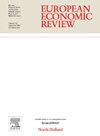Labour at risk
IF 2.8
2区 经济学
Q1 ECONOMICS
引用次数: 0
Abstract
We propose a Bayesian VAR model with stochastic volatility and time varying skewness to estimate the degree of labour at risk in the euro area and in the United States. We model the asymmetry of the shocks to changes in the unemployment rate as a function of real activity and financial risk factors. We find that the conditional distribution of the changes in the unemployment rate displays time-varying volatility and skewness, with peaks coinciding with the Global Financial Crisis and the COVID-19 pandemic, in both areas. We also take advantage of the multivariate nature of our parametric model to measure the joint risk of large increases in the unemployment rate together with large annual rates of inflation, a proxy for “stagflation” risks. The model captures an increase of the risk of stagflation with the surge in inflation that followed the recent energy crisis in 2022. Nevertheless, stagflation risks were contained by the resilient performance of the labour market in both areas. Labour at risk is therefore important for the assessment of the inflation-unemployment trade-off.
面临风险的劳动力
我们提出了一个具有随机波动性和时间变化偏度的贝叶斯 VAR 模型,以估算欧元区和美国的劳动力风险程度。我们将失业率变化所受冲击的非对称性作为实际活动和金融风险因素的函数进行建模。我们发现,失业率变化的条件分布显示出随时间变化的波动性和偏度,两个地区的峰值都与全球金融危机和 COVID-19 大流行相吻合。我们还利用参数模型的多变量性质来衡量失业率大幅上升与年通胀率大幅上升的共同风险,即 "滞胀 "风险。该模型捕捉到了 2022 年近期能源危机后通胀飙升所带来的滞胀风险的增加。尽管如此,由于劳动力市场在这两个领域的弹性表现,滞胀风险得到了遏制。因此,面临风险的劳动力对于评估通货膨胀与失业之间的权衡非常重要。
本文章由计算机程序翻译,如有差异,请以英文原文为准。
求助全文
约1分钟内获得全文
求助全文
来源期刊

European Economic Review
ECONOMICS-
CiteScore
4.70
自引率
3.60%
发文量
170
期刊介绍:
The European Economic Review (EER) started publishing in 1969 as the first research journal specifically aiming to contribute to the development and application of economics as a science in Europe. As a broad-based professional and international journal, the EER welcomes submissions of applied and theoretical research papers in all fields of economics. The aim of the EER is to contribute to the development of the science of economics and its applications, as well as to improve communication between academic researchers, teachers and policy makers across the European continent and beyond.
 求助内容:
求助内容: 应助结果提醒方式:
应助结果提醒方式:


